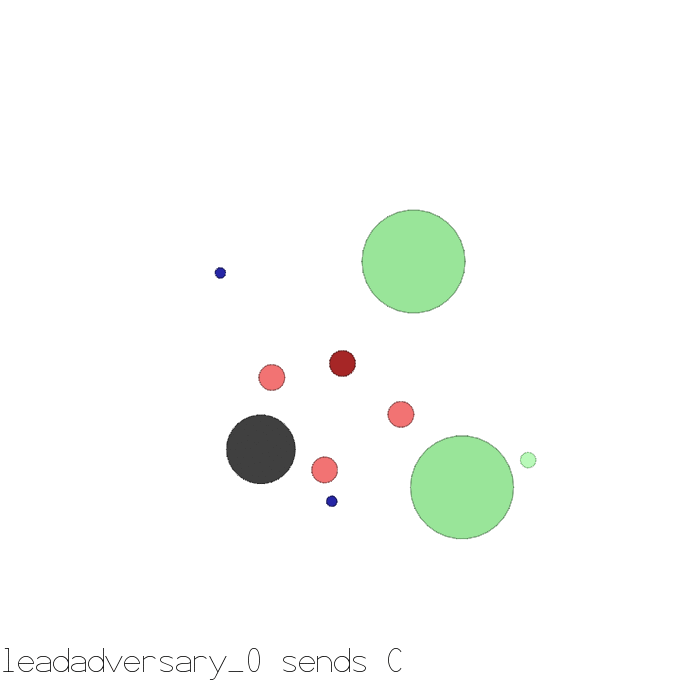Simple World Comm¶

Warning
The environment pettingzoo.mpe.simple_world_comm_v3 has been moved to the new MPE2 package, and will be removed from PettingZoo in a future release. Please update your import to mpe2.simple_world_comm_v3.
This environment is part of the MPE environments. Please read that page first for general information.
Import |
|
|---|---|
Actions |
Discrete/Continuous |
Parallel API |
Yes |
Manual Control |
No |
Agents |
|
Agents |
6 |
Action Shape |
(5),(20) |
Action Values |
Discrete(5),(20)/Box(0.0, 1.0, (5)), Box(0.0, 1.0, (9)) |
Observation Shape |
(28),(34) |
Observation Values |
(-inf,inf) |
State Shape |
(192,) |
State Values |
(-inf,inf) |
This environment is similar to simple_tag, except there is food (small blue balls) that the good agents are rewarded for being near, there are ‘forests’ that hide agents inside from being seen, and there is a ‘leader adversary’ that can see the agents at all times and can communicate with the other adversaries to help coordinate the chase. By default, there are 2 good agents, 3 adversaries, 1 obstacles, 2 foods, and 2 forests.
In particular, the good agents reward, is -5 for every collision with an adversary, -2 x bound by the bound function described in simple_tag, +2 for every collision with a food, and -0.05 x minimum distance to any food. The adversarial agents are rewarded +5 for collisions and -0.1 x minimum
distance to a good agent. s
Good agent observations: [self_vel, self_pos, landmark_rel_positions, other_agent_rel_positions, self_in_forest, other_agent_velocities]
Normal adversary observations:[self_vel, self_pos, landmark_rel_positions, other_agent_rel_positions, other_agent_velocities, self_in_forest, leader_comm]
Adversary leader observations: [self_vel, self_pos, landmark_rel_positions, other_agent_rel_positions, other_agent_velocities, self_in_forest, leader_comm]
Note that when the forests prevent an agent from being seen, the observation of that agents relative position is set to (0,0).
Good agent action space: [no_action, move_left, move_right, move_down, move_up]
Normal adversary action space: [no_action, move_left, move_right, move_down, move_up]
Adversary leader discrete action space: [say_0, say_1, say_2, say_3] X [no_action, move_left, move_right, move_down, move_up]
Where X is the Cartesian product (giving a total action space of 50).
Adversary leader continuous action space: [no_action, move_left, move_right, move_down, move_up, say_0, say_1, say_2, say_3]
Arguments¶
simple_world_comm_v3.env(num_good=2, num_adversaries=4, num_obstacles=1,
num_food=2, max_cycles=25, num_forests=2, continuous_actions=False, dynamic_rescaling=False)
num_good: number of good agents
num_adversaries: number of adversaries
num_obstacles: number of obstacles
num_food: number of food locations that good agents are rewarded at
max_cycles: number of frames (a step for each agent) until game terminates
num_forests: number of forests that can hide agents inside from being seen
continuous_actions: Whether agent action spaces are discrete(default) or continuous
dynamic_rescaling: Whether to rescale the size of agents and landmarks based on the screen size
Usage¶
AEC¶
from pettingzoo.mpe import simple_world_comm_v3
env = simple_world_comm_v3.env(render_mode="human")
env.reset(seed=42)
for agent in env.agent_iter():
observation, reward, termination, truncation, info = env.last()
if termination or truncation:
action = None
else:
# this is where you would insert your policy
action = env.action_space(agent).sample()
env.step(action)
env.close()
Parallel¶
from pettingzoo.mpe import simple_world_comm_v3
env = simple_world_comm_v3.parallel_env(render_mode="human")
observations, infos = env.reset()
while env.agents:
# this is where you would insert your policy
actions = {agent: env.action_space(agent).sample() for agent in env.agents}
observations, rewards, terminations, truncations, infos = env.step(actions)
env.close()


